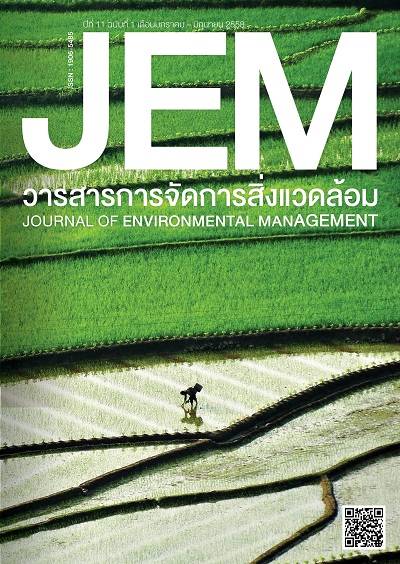การประยุกต์กระบวนการนโยบายสาธารณะแบบมีส่วนร่วมในการพัฒนามหาวิทยาลัยสีเขียวของมหาวิทยาลัยราชภัฏพิบูลสงคราม จังหวัดพิษณุโลก
DOI:
https://doi.org/10.14456/jem.2015.5บทคัดย่อ
การศึกษาครั้งนี้มุ่งศึกษาการประยุกต์ใช้กระบวนการนโยบายสาธารณะแบบมีส่วนร่วมในการพัฒนามหาวิทยาลัยสีเขียวของมหาวิทยาลัยราชภัฏพิบูลสงคราม โดยใช้วิธีการศึกษาวิจัยเชิงคุณภาพ เครื่องมือที่ใช้ ได้แก่ การสังเกตการณ์แบบมีส่วนร่วม การสัมภาษณ์แบบเชิงลึกจากผู้ให้ข้อมูลสำคัญและการสรุปบทเรียน โดยใช้เทคนิคการเรียนรู้ระหว่างงานเพื่อนำมาวิเคราะห์เนื้อหา และสังเคราะห์ในรูปแบบของแนวนโยบายจากกระบวนการนโยบายแบบมีส่วนร่วม การศึกษาในครั้งนี้จำกัดขอบเขตการศึกษาอยู่ในระดับของการก่อรูปเชิงนโยบายและกำหนดนโยบาย เพื่อนำไปสู่การปฏิบัติร่วมกันภายในองค์กรต่อไป ผลการศึกษาแสดงให้เห็นว่ากระบวนการของนโยบายสาธารณะแบบมีส่วนร่วมเป็นรูปแบบของการสร้างนโยบายจากล่างขึ้นสู่บน ผ่านกระบวนการสร้างเครือข่ายเชิงนโยบายระหว่างกลุ่มหรือภาคส่วนต่างๆ และการแลกเปลี่ยนเรียนรู้ร่วมกัน โดยปัจจัยหลักสำคัญที่จะทำให้การปรับใช้กระบวนการนโยบายสาธารณะแบบมีส่วนร่วมประสบความสำเร็จ คือ การมีกลไก กระบวนการและทิศทางที่ชัดเจน การเปิดพื้นที่ทางสังคมให้เกิดกระบวนการแลกเปลี่ยนเรียนรู้ร่วมกันผ่านการปฏิบัติ การสื่อสารประชาสัมพันธ์ข้อมูล และการพัฒนาเครือข่ายเชิงนโยบาย ที่มีความเกี่ยวข้องสัมพันธ์กันเพื่อให้เกิดการขับเคลื่อนโยบายร่วมกันอย่างมีประสิทธิภาพ
The purpose of this research was to study the application of the participatory public policy process in the green university development of Pibulsongkram Rajabhat University, Phitsanulok, in the lower northern part of Thailand. This study was of a qualitative research design, and utilized participant observation, in-depth interviews with the key informants, and learning summary by using the after-action review technique. Then, the data was analyzed by the content analysis method and synthesized through the participatory public policy process. This study focuses on policy formation and the policy formulation level of the participatory public policy process. The results of the study revealed that the participatory public policy process is a bottom-up policy model, and it can be supplemented by creating a policy network and interactive learning. The important factors that led to the success of the participatory public policy process were: clarity of the policy mechanism, process and direction; social space openness for interactive-learning through action among the participants; and communication and policy network development to support policy efficiency
เอกสารอ้างอิง
[AASHE] Association for the Advancement of Sustainability in Higher Education. (2011). AASHE Mission, Vision
and Goals. Retrieved September 8, 2014, from http://www.aashe.org/about/aashe-mission-vision-goals
[AASHE] Association for the Advancement of Sustainability in Higher Education. (2013). Higher Education Sustainability Review. Retrieved May 5, 2014, from http://www.aashe.org/publications/sustainability-review
Boon-ake, K., Kaewngao, S. & Wachirawongsakorn, P. (2011). Current Situation on Solid Waste Management in Pibulsongkarm Rajabhat University [In Thai]. Rajabhat Journal of Science, Humanities & Social Science, 12(2), 74 – 90.
Chimjan, O., Sangyoka, S., Wachirawongsakorn, P. & Srithawirat, T. (2013). Current learning for step forward to the future of Pibulsongkram Rajabhat University [In Thai: เรียนรู้ปัจจุบันเพื่อก้าวไปสู่อนาคตของมหาวิทยาลัยราชภัฏพิบูลสงคราม]. Academic document of Environmental Science department, Faculty of Science and Technology, Pibulsongkram Rajabhat University.
Chimjan, O. (2013a). Report study in the suitability of the water supply system of Pibulsongkram Rajabhat University (Thale Kaew Campus) [In Thai:รายงานการศึกษาความเหมาะสมของระบบผลิตน้ำประปาของมหาวิทยาลัยราชภัฏพิบูลสงคราม (ส่วนทะเลแก้ว)]. Faculty of Science and Technology, Pibulsongkram Rajabhat University.
Chimjan, O. (2013b). Report study in Assessment of Wastewater Management of Pibulsongkram Rajabhat University (Phase 1) [In Thai:รายงานการประเมินศักยภาพในการจัดการน้ำเสียของมหาวิทยาลัยราชภัฏพิบูลสงคราม ระยะที่ 1]. Faculty of Science and Technology, Pibulsongkram Rajabhat University.
Chuengsatiansup, K. (2013). Health Assembly: Philosophy and Psychology [In Thai: สมัชชาสุขภาพ ปรัชญา แนวคิดและจิตวิทยา]. Bangkok: National Health Commission Office of Thailand.
Khongouan, W. & Sitachitta, P. (2010). The management of Green Area in Educational Institutions in accordance with the Action Policy of Green AreaManagement in Sustainable City [In Thai]. Academic Journal of Architecture, Chulalongkorn university, 59, 141 – 150.
Khongouan, W. & Sitachitta, P. (2011). Managing green Area in educational institutions: A Case Study in Thammasat University Rangsit Center [In Thai]. Journal of The Faculty of Architecture King Mongkuts Institute of Technology Ladkrabang,13(13), 74 – 87.
Mahidol University. (2014). Mahidol University has been ranked 1st in Thailand and 31st worldwide by UI Green Metric World Universities Ranking 2013 [In Thai]. Retrieved September 8, 2557, from http://www.mahidol.ac.th/th/latest_news57/UI_Green.html
National Health Commission Office of Thailand. (2012). Assembly process, mechanism, and guidelines process [In Thai:
กระบวนการสมัชชา กลไกและแนวทางการจัดกระบวนการ]. Bangkok: National Health Commission Office of
Thailand.
Pibulsongkram Rajabhat University. (2010). Announcement of Pibulsongkram Rajabhat University on Energy Conservation Policy issued on January, 29, 2010 [In Thai:ประกาศมหาวิทยาลัยราชภัฏพิบูลสงคราม เรื่องนโยบายอนุรักษ์พลังงาน ลงวันที่ 29 มกราคม 2553]. Pibulsongkram Rajabhat University.
Pibulsongkram Rajabhat University. (2013). Learning Conclusion of Green University participatory public policy
development committee meeting on 21 October, 2013 [In Thai: สรุปบทเรียนการประชุมคณะกรรมการพัฒนา
นโยบายสาธารณะแบบมีส่วนร่วม มหาวิทยาลัยสีเขียว]. Pibulsongkram Rajabhat University.
Pibulsongkram Rajabhat University. (2014). Master Plan of Green University Development of Pibulsongkram Rajabhat University (2014-2020) [In Thai:แผนแม่บทการพัฒนามหาวิทยาลัยสีเขียว มหาวิทยาลัยราชภัฏพิบูลสงคราม (2557-2560)]. Pibulsongkram Rajabhat University.
Pibulsongkram Rajabhat University, Division of Central administration (2012). Energy system management 2012 Annual Report [In Thai:รายงานการจัดการพลังงาน ประจำปีงบประมาณ 2555]. Pibulsongkram Rajabhat University.
Pibulsongkram Rajabhat University, Education Service Division. (2013). Student Statistic of semester 2/2013 categorized by faculty, program and sex [In Thai]. Retrieved May 5, 2014, from http://www.reg.psru.ac.th/free.html
Phitsanulok Hotnews. (2013). Local urgent discuss to solving no waste dumping area [In Thai: ท้องถิ่นถกด่วนแก้ปัญหาไม่มีที่ทิ้งขยะ]. Retrieved May 5, 2014, from http://www.phitsanulokhotnews.com/2013/09/10/42819.
QS Worldwide university rankings. (2012). Green Universities. Retrieved May 5, 2014, from http://www.topuniversities.com/student-info/choosing-university/green-universities
Thamrongthanyawong, S. (2001). Public Policy: Concepts Analysis and Processes [in Thai: นโยบายสาธารณะ: แนวคิด การวิเคราะห์ และกระบวนการ]. Bangkok: National Institute of Development Administration.
Thawatchai Buakaw and Monsicha Bejrananda. (2012). Policy and Strategy Formation Towards ‘Green University’: a
Case of Thaksin University, Phatthalung Campus [In Thai]. Journal of The Faculty of Architecture King
Mongkuts Institute of Technology Ladkrabang, 14(14), 40 – 55.
UI GreenMetric World University Ranking.(2013). Criteria & Indicator. Retrieved June 21, 2014, from http://greenmetric.ui.ac.id/page/criteria
Wasi, P. (2009). Public Policy Process [In Thai:กระบวนการนโยบายสาธารณะ]. Bangkok: Beyond Publishing.



